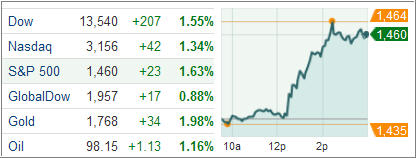Extending their winning ways for the third straight session after the US Federal Reserve opted for a third round of quantitative easing to boost growth, the S&P 500 rallied to its highest level since 2007 Thursday.
The Dow Jones Industrial Average (DJIA) leapt 207 points, the highest since December 2007. Within the blue-chip index, breadth remained absolutely positive with all the 30 components closing the day higher.
The S&P 500 Index (SPX) jumped 23 points with financials leading the day’s gainers that included all the 10 business sectors. Today’s close also marked the index’s highest since December 2007.
Personally, I did not expect the Fed to put QE-Extreme on the table at this point. You could argue that it was an act of desperation as the jobs situation is not improving at all. With the major indexes hovering at 4 year highs it makes me wonder what ammunition, if any, the Fed has left in its arsenal should the markets head south and reach a point where a Fed assist is needed.
We have now catapulted further into bubble territory as economic fundamentals have been totally ignored, which means that these levels are supported by nothing more than hot hair. Is the Fed’s goal to reflate the stock market bubble?
Here’s any analysis by ZeroHedge on the topic:
If there was one absolutely must see moment exposing everything that is broken with the Fed’s brand new policy of QE-nfinity, it was this exchange between Reuters’ Pedro da Costa and the Chairman.
It explains, beyond a reasonable doubt, that the only goal the Fed now has is to reflate the stock market bubble to previously unseen levels, to focus on generating jobs although not for everyone but only for Wall Street, consequences be damned, because by the time the consequences arrive, and they will (just recall that subprime is contained) they will be some other Fed chairman’s problem. Bernanke’s term mercifully runs out in January 2014.
Treasury prices reclaimed lost ground after slipping earlier following Ben Bernanke’s decision to extend indefinitely the central bank’s bond purchase program by buying mortgage-backed securities.
The greenback meanwhile extended losses for the third straight session as risk sentiment improved following the US Fed’s decision to extend the monetary stimulus program through mortgage-backed assets purchase program. The dollar index, a gauge of the USD’s strength against a basket of six global peers, slid to 79.254 from 79.686.
European stocks however closed lower as markets remained wary before the imminent conclusion of the two-day FOMC meeting. Snapping a two-day winning streak, the pan-European Stoxx Europe 600 index fell 0.2 percent Thursday.
In the ETF space, precious metals and natural resources related funds outperformed for the day. The Global X Silver Miners ETF (SIL) soared an eye-popping 7.5 percent on the day as silver prices jumped after the Fed’s new stimulus plan was announced.
The iShares Silver Trust (SLV) surged 4.35 percent while the State Street SPDR Gold Trust (GLD) rose 2.02 percent after December gold futures rose 2 percent. Asia linked funds also made decent gains with the SPDR S&P China ETF (GXC) rising 2.20 percent while the Vanguard Emerging Markets ETF (VWO) jumping 2.55 percent.
As risk sentiment improved following Fed’s stimulus announcement, the so-called fear-tracking CBOE Volatility Index (VIX) slumped to a multi-month low. The ProShares VIX Short-Term Futures ETF (VIXY) was among the day’s biggest percentage decliners, losing a whopping 7.30 percent on the day.
For the effect on our Trend Tracking Indexes (TTIs) and ETF/Mutual Fund momentum numbers, please see the latest StatSheet, which I will post within the hour.
Disclosure: No holdings
Contact Ulli
